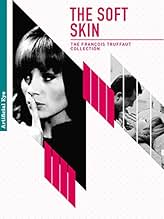Pierre Lachenay is a well-known publisher and lecturer, married with Franca and father of Sabine, around 10. He meets an air hostess, Nicole. They start a love affair, which Pierre is hiding... Read allPierre Lachenay is a well-known publisher and lecturer, married with Franca and father of Sabine, around 10. He meets an air hostess, Nicole. They start a love affair, which Pierre is hiding, but he cannot stand staying away from her.Pierre Lachenay is a well-known publisher and lecturer, married with Franca and father of Sabine, around 10. He meets an air hostess, Nicole. They start a love affair, which Pierre is hiding, but he cannot stand staying away from her.
- Awards
- 1 win & 2 nominations total
- Nicole
- (as Françoise Dorleac)
- Lisbon organizer
- (uncredited)
- Le père de Nicole
- (uncredited)
- Jeune fille Reims
- (uncredited)
- Mme. Leloix
- (uncredited)
- Veilleur hôtel Michelet
- (uncredited)
- Director
- Writers
- All cast & crew
- Production, box office & more at IMDbPro
Storyline
Did you know
- TriviaThe scenes set in Pierre Lachenay's apartment were filmed in Truffaut's own home.
- GoofsWhen Pierre is about to slip Nicole's phone number into his wallet, the close-up of the wallet has a different background (desk with white paper) than the previous medium shot.
- Quotes
Pierre Lachenay: I've learned that men's unhappiness arises from the inability to stay quietly in their own room.
- ConnectionsFeatured in François Truffaut: Portraits volés (1993)
- SoundtracksPierre Et Nicole
Written and Performed by Georges Delerue Et Son Orchestre
1. The main character is not very likeable; he's almost completely expressionless even though this is a love story. 2. Certain events happen in a way that isn't exactly realistic: an elevator takes nearly 2 minutes to travel up 5 floors but only 15 seconds on the way down. 3. Certain events happen without any dialogue or explanation, just a succession of close ups showing objects and activity. But these 3 points are very deliberate, and they are what make "La peau douce" such a tremendous work of art.
1. Why is the main character not likeable? As Truffaut said, this film is "an autopsy of adultery". The story is about a respectable man with a meticulously perfect life who engages in a very imperfect affair. Truffaut wanted to present everything as objectively as possible so that we can analyze all the elements without the prejudice of sentimentality. So he made the lead actor Jean Desailly play the role of "Lachenay" with neutrality; we sense deep emotion, but there are no melodramatic scenes of outward expression as we've come to expect in love stories. If you think about it, isn't that how most people's love lives are? We don't usually get dramatic closeups with soft lighting and complimentary filters. An objective observer woudn't necessarily sympathize with what we're feeling but rather would scrutinize our actions & choices. And as far as that goes. Lachenay makes some pretty bad ones.
2. How realistic is the storytelling? At times, not very. But this style is one of the greatest examples of "hyper realism" which is something Truffaut learned from his mentor and idol Alfred Hitchcock. For example in the elevator scene, time is stretched on the way up, intensifying the first meeting between Lachenay and Nicole (excellently played by Françoise Dorléac, the carefree, outgoing sister of Catherine Deneuve). Only a handful of words are said, but in true Hitchcockian form it's a very suspenseful and portentous scene that deserves its full 2 minutes. The same elevator ride down, with Lachenay alone, is designed to give us contrast and return us to the realistic world as the 5-floor descent is shown in real time, only 15 seconds.
3. Dude where's the dialogue? It's there, but sometimes it's conspicuously absent like in the entire seduction scene which consists of a wordless walk down a hotel hallway, a fumbling for some keys, a lingering stare, hands touching as a door is opened, one hand turning on the light while another hand turns it off, and finally a magnificent dark silhouette of 2 people facing each other. Fade to black. Did we really need any dialogue to understand exactly what was going on in their heads? No, we didn't even need any facial expressions. Again drawing an idea from his hero Hitchcock, even taking the idea into new territory, Truffaut fully embraced the idea of image based storytelling. (In his letter of introduction to Hitch, Truffaut closed by saying that if all movies were suddenly silent again, then Hitchcock would prove himself the greatest storyteller of all time.)
A quick note about the ending (NO SPOILERS) because half a dozen other reviewers seem to have a problem with it: Um you guys realize that the ending was taken from an event that actually happened in real life, right? Look it up (AFTER the film)!
There are so many other gems in this film worth mentioning, but my review would drag on for hours, and that time is better spent with you experiencing this flick firsthand. Audiences of 1964 hated it, but now looking back some 70 years, we realize that "La peau douce" is a masterpiece.
- How long is The Soft Skin?Powered by Alexa
Details
Box office
- Gross US & Canada
- $509
- Opening weekend US & Canada
- $11,206
- Apr 25, 1999
- Gross worldwide
- $30,706
- Runtime1 hour 53 minutes
- Color
- Sound mix
- Aspect ratio
- 1.66 : 1
Contribute to this page


![Watch Bande-annonce [OV]](https://m.media-amazon.com/images/M/MV5BYzY4NmVmYjItNzQ2MS00MDU4LThlODctYjliMTRhM2ZmY2MwXkEyXkFqcGdeQXRyYW5zY29kZS13b3JrZmxvdw@@._V1_QL75_UX500_CR0)




























